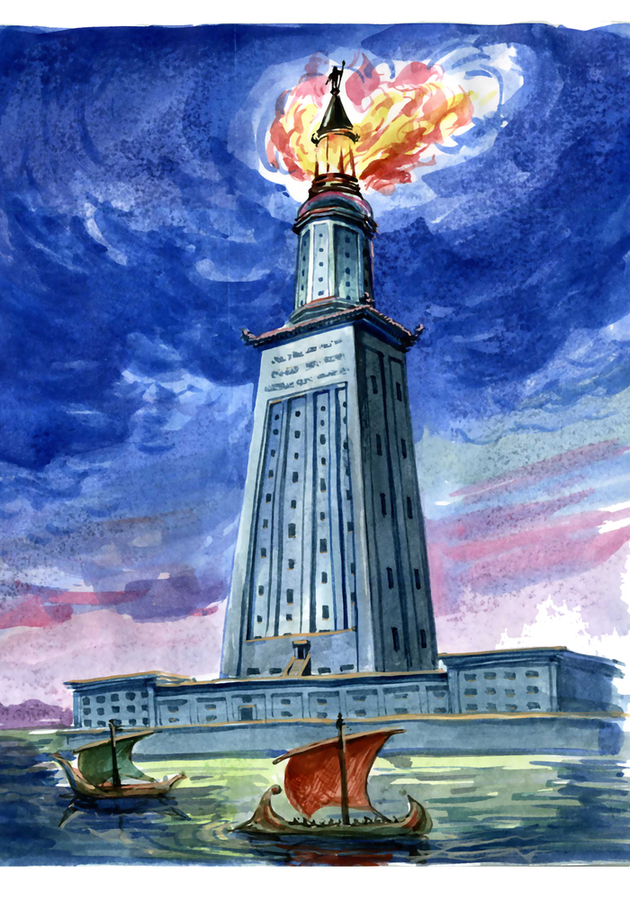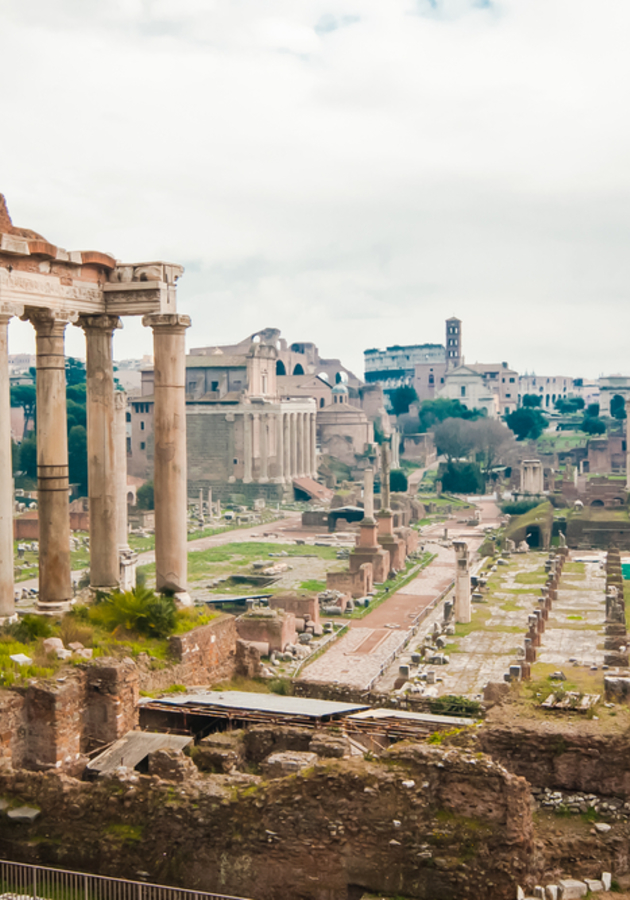In the autumn of 1994, a team of French archaeologists led by Jean-Yves Empereur dived into the waters of Alexandria’s Eastern Harbor. Ever since the Renaissance, tales were told of fabulous statues and engraved blocks that were littered across the seafloor just outside the harbor, but, until 1994, the area was off-limits to scientific investigation, since it was a military zone. It wasn’t long before Empereur and his team shocked the world when they proved the legends true, announcing the discovery of over 2,500 architectural blocks, weighing more than 70 tons.
There were, among the findings, pieces of numerous ancient columns and capitals, fragments of no less than 26 sphinxes and 5 obelisks, and two colossal statues of the 3rd century BC, depicting the then-ruling couple, Ptolemy Philadelphus and Queen Arsinoë II. There was also something else that could be dated back to the same period: several indisputable remains of the Lighthouse of Alexandria. One of the Seven Wonders of the Ancient World, the Lighthouse was, for many centuries, the tallest non-pyramidal structure in the world. It was built at a time of great prosperity in the region and represented the outstanding economic growth and artistic achievements of a thriving, recently founded city.
The foundation of Alexandria
When in April 331 BC, Alexander the Great first passed by the northern coast of Egypt on the Nile Delta, there was nothing there but a little fishing village named Rhacotis and, just off the shoreline, a limestone islet sticking up above the sand and mud, referred to by locals as Pharos. It wasn’t precisely what Alexander had expected to see, considering the fact that he had been guided to the site by a celestial vision. The night before, as soon as he had gone to bed, a man with hoary looks and a venerable figure appeared to him in his dreams, and recited in his ear the following verse from Homer’s “Odyssey”: “Now, there is an island in the surging sea, in front of Egypt, and Pharos is what people call it.” Alexander had recently conquered Egypt and, wanting to establish a large and populous Greek city there which should bear his name, he was in the middle of measuring off and enclosing a certain site for it down the Nile. The dream-vision changed his mind.
Convinced that he had been visited by Homer himself, Alexander organized an expedition to Pharos that very night. The following morning, after the initial disappointment, he was happy to realize that he had made the right choice. Indeed, after seeing the natural advantages of the site, Alexander had to admit that Homer was not only admirable as a poet, but was also a very wise architect. Immediately he ordered the plan of the new city to be drawn in conformity with the site. In the absence of chalk, Dinocrates of Rhodes, Alexander’s main architect and technical adviser, used barley-meal and produced a wonderful modern-looking grid with a main street running from east to west. As soon as Alexander expressed his approval of the design, a flock of birds of every sort and size descended upon the place like a cloud and devoured every little speck of the barley-meal.
Alexander was greatly disturbed at the omen. His seers, however, weren’t. “It’s nothing bad,” said one of them. “It just means that the city you’re about to establish here will have the most abundant and helpful resources, and become a nursing mother for people of every race and nation.” Alexander’s seers were right: within a few decades, the newly-founded city became a commercial, cultural and intellectual hub of the Hellenistic ancient world. Just like 19 other cities established by the great ruler, it assumed the name Alexandria and acted, under that name, as the capital of Ptolemaic Egypt, the wealthiest and most powerful of the three successor states to Alexander’s world empire. Fittingly, after Alexander’s death, it also became his final resting place, even if contrary to his wishes. In 321 BC, on its way back to Macedonia, Alexander’s body was hijacked in Syria by Ptolemy I and subsequently interred in a grandiose mausoleum in Alexandria so as to fix the city’s preeminence in the world. Indeed, it did.
An intellectual and cultural hub
Not only did Alexander’s tomb become the focal point for the Ptolemaic cult of Alexander the Great, it also served as a robust justification for Alexandria’s very existence. In brief time, the city didn’t need any: as wealthy people began flocking to Alexandria to visit Alexander’s tomb, palaces with magnificent gardens began popping up along the harbor, and within a single generation, the city became the center of the new commerce between Europe and the Arabian and Indian East. In 305 BC, Alexander’s former general Ptolemy declared himself Pharaoh of Egypt and moved his capital from Memphis to Alexandria. By the time he abdicated in favor of his son in 285 BC, Alexandria had already grown to become one of the largest cities in the world. Soon enough, it also became the global center of Hellenistic scholarship and science.
Already during the reign of Ptolemy I Soter, an exiled Athenian statesman by the name of Demetrius of Phalerum proposed to him the establishment of a universal library in Alexandria. Even though Ptolemy liked the idea, he never had the time or resources to turn it into reality. Fortunately, the project was taken up by Ptolemy’s son, Ptolemy II Philadelphus, who founded, during his reign, two buildings of remarkable historical significance: a research institution called the Museum, which served as a sort of ancient university, and, within it, a marvelous library which, in short time, became the greatest in the ancient world. Thanks to the Ptolemaic kings’ aggressive and well-funded policies for acquiring texts, at its height, the Great Library of Alexandria housed almost half a million papyrus scrolls. It was there that the definite texts of ancient writers were first established, to be sent around the world in copies, which, copied again, have in some cases survived to this day and form the basis of our knowledge of ancient literature and thought.
Such scholars as Euclid, Archimedes, Plotinus, Ptolemy and Eratosthenes studied and worked at the Museum. It was there that engineer-inventors, such as Ctesibius, Philo of Byzantium and Hero of Alexandria, devised contraptions and devices of such complexity that some of them may seem even anachronistic to modern eyes. Discovered in 1901, the famous Antikythera mechanism was probably the world’s first analogue computer, and certainly the only one in existence until the European Renaissance. Hero’s radial turbine, known as “aeolipile” in the ancient world, can be considered a true precursor of the steam engine which, a full two millennia later, propelled humanity into the Industrial Age. In retrospect, the Hellenistic world came really close to our modernity. But just like the Museum and the Library, it was quickly hurled into ruins and oblivion by religious zeal, mostly Christian. It was ingenious engineers with modern beliefs that built the Alexandria lighthouse. Originally, however, they didn’t mean to build one.
The lightless lighthouse
Work on the Alexandria lighthouse began under Ptolemy I, but the building was dedicated in the reign of his son, Ptolemy II, quite possibly in 282 BC. In that very year, on the other side of the Mediterranean Sea, a brilliant sculptor named Chares removed the mound of earth around a gigantic statue to reveal to the curious onlookers the glory of another of the Seven Wonders of the Ancient World: the Colossus of Rhodes. Unlike in the case of that monument, we don’t know for sure who designed the Lighthouse of Alexandria, but one name which repeatedly turns up in the context is Sostratus of Cnidus. Ancient Greek geographer Strabo claims that such a name stood at the dedicatory inscription on the base of the Lighthouse. Roman polymath Pliny goes a step further and mentions “the generous spirit shown by King Ptolemy, whereby he allowed the name of the architect, Sostratus of Cnidus, to be inscribed on the very fabric of the building.” The most memorable story, however, was written somewhat later, by 2nd-century Roman-Syrian pamphleteer Lucian of Samosata.
“Sostratus,” tells us Lucian, “built the Tower on Pharos, the mightiest and most beautiful work of all, so that a beacon-light might shine from it for sailors far over the sea. After he had built the work, he wrote his name on the masonry inside, covered it with gypsum, and having hidden it, inscribed the name of the reigning king above. He knew, as it actually happened, that in a very short time the letters would fall away with the plaster and that there would be revealed another inscription: ‘Dedicated by Sostratus of Cnidus, the son of Dexiphanes, to the Divine Saviours, for the sake of them that sail at sea.’” There are two problems with Lucian’s beautiful story. First of all, unless there were two people of the same name, rather than an architect, Sostratus of Cnidus might have been a diplomat, since someone by that time was surely sent by Ptolemy II Philadelphus as an ambassador to Delos in the 270s. And secondly, the main architect of the Lighthouse, whoever he was, could have never written such an inscription, since he couldn’t have known he was building a lighthouse.
Without a doubt, the Pharos Tower was originally conceived without the light, perhaps as a simple daytime landmark. After all, there were no lighthouses anywhere at the time, which must seem reasonable in view of the fact that ancients preferred to sail by day whenever possible. Moreover, until Roman times, we can find neither a mention of the light inside the tower nor evidence of systematic use of lighted beacons for navigational purposes in the Mediterranean. Hence, whenever a source of light was finally added to the monument, it made the Pharos Tower the first architecturally designed lighthouse in history. That’s why the name of the islet it was built on became the etymological origin of the word “lighthouse” in Greek: “pharos”; in Ancient Egyptian, the word probably meant “Pharaoh's island.” Later on, the island gave its name to the French, Italian, and Spanish words for lighthouse: “phare” and “faro.” Even in English, the Lighthouse is often identified as the Pharos of Alexandria, just as it was known around the world for centuries.
Appearance and height
Even though not much of the Alexandrian Lighthouse is left for inspection today – not even underwater – a combination of quite varied evidence makes it possible for us to know more about it than perhaps any of the other wonders, except the still intact Pyramids. Just for comparison, albeit built at about the same time and in exactly the same cultural context, the Colossus of Rhodes hasn’t survived in a single pictorial representation, not even as a wreck. Conversely, hundreds of Alexandrian coins of Roman times, stretching from the imperial reigns of Domitian through to Commodus, hold simplified depictions of the Pharos, testifying to its iconographical impact on the Alexandrians’ idea of themselves. Moreover, the Lighthouse was frequently described by classical authors, such as Strabo and Pliny, and, in its latter days, by Arab historians and geographers, whose accounts are both more thorough and consistent than those of Graeco-Roman writers.
It is to Arab authors that we owe our knowledge of the true size of the Pharos. Whereas among Ancient Greek writers there was a tendency to inflate dimensions, the Arabs were quite precise. The heights they give vary only a little between each other, and modern researchers have used them to deduce that the total height of the Lighthouse, counting the foundation base, was exactly 384 feet (118 m), equivalent to a thirty-five-story building. A three-tiered tower with rectangular windows on all sides, it was probably constructed in three phases. The lowest section was a square measuring 183 feet (56 m) high with a cylindrical core. The middle part was an octagonal shape with a height of 90 feet (27.5 m) and a side length of 60 feet (18.3 m). Finally, the third part, 24 feet high (7.3 m), was cylindrical in shape and encircled with a broad spiral ramp. At the top, there stood a 16-foot (5-meter) statue, either of Alexander the Great or King Ptolemy I in the trappings of the sun god Helios.
Ancient coins add further details to our picture of the Pharos, such as several statues of Poseidon’s son Triton on top of the first level. Some of these coins have a Zeus statue on top, and it’s possible that the original sculpture was replaced at one time or another. Al-Masudi, the Herodotus of the Arabs, informs us that in the 10th century, the eastern side of the Pharos carried, in full view of arrivals and departures at the harbors, a large-letter inscription dedicated to Zeus. There was no such inscription in antiquity. In Roman times, the Lighthouse saw a much bigger change than this one, as Alexandrians decided to add fire at either its base or the top. Reflected out to sea by enormous mirrors, possibly made of burnished bronze, the light from the fire was said to be visible across the Mediterranean for 300 stadia, or about 34 miles (50 km), a day’s sail away. Statius compared it to the moon. “From afar,” wrote Pliny, “the Pharos fire may be mistaken for a star.”
Later history and destruction
Early in the second century AD, Roman-Greek writer Achilles Tatius, who lived in Alexandria, described the Lighthouse as “the most remarkable and extraordinary structure” of the world. “It is like a mountain,” he wrote, “almost reaching the clouds, in the middle of the sea. Below it, flow the waters: it almost seems as if it is suspended above their surface. At its top, most beautiful of all, there rises a second sun to be a guide for ships.” How did the Alexandrians fuel the fire to produce this “second sun” – we don’t really know. Wood was always in short supply in Egypt, and it’s hard to imagine a sufficient supply of dried animal dung, which we know the Egyptians used in cooking. Perhaps the fire at the Lighthouse was fueled by bundles of papyrus roots or perhaps it was fueled by naphtha. Either way, it shone brightly for centuries, a majestic symbol of Alexandria’s greatness and prosperity.
In AD 641, Alexandria fell to the Muslims. Some time later, the Arab conquerors removed the statue of Zeus on the top of the Lighthouse and replaced it with a mosque. By happy coincidence, a mosaic in St Mark’s Basilica in Venice – which shows a boat arriving in the harbor at Alexandria – keeps a pictorial record of the Lighthouse at this stage. If we are to believe Al-Masudi, the mosque might have been only raised after the caliph demolished the mirrors and the upper part of the Tower by accident, while trying to unearth some fabled treasure belonging to Alexander the Great. Be that as it may, the design of minarets in many early Egyptian Islamic mosques followed a three-stage design similar to the Lighthouse. Hence, it has been suggested that the dometopped phase of the Pharos served as a model for the minarets of all mosques thereafter. It can’t be a simple coincidence that, in Arabic, “al-Manarah” means both “minaret” and “lighthouse.”
The Lighthouse was badly damaged in an earthquake in 956 and fell into slow disintegration after the two great quakes of the 14th century, in 1303 and 1323. Already in 1326, Muslim Moroccan explorer Ibn Battuta wrote that the building was partially in ruins. When he saw it again in 1349, there was even less left of it and it was no longer possible to get up to the entrance door in its lower section, due to the collapsed granite blocks. One of the last authors to write of the Pharos was historian Al-Maqrizi, from whom we learn that a third earthquake shook the already tattered monument to its foundations in 1375. The third-longest surviving ancient wonder – after the Mausoleum at Halicarnassus and the Pyramid of Giza – the damaged Pharos persisted, in parts, for an entire century afterward. In 1480, the last of its remnant stones were either hurled into the sea or used to build the Citadel of Qaitbay, a defensive fortress. Beautiful in itself, the Citadel stands to this day. An Egyptian flag adorns its top, fluttering at a height where, for millennia, there fluttered radiantly bright, starlike fire.
Sources
Main
- Paul Jordan, Seven Wonders of the Ancient World (Routledge, 2002).
- Christopher Scarre, ed. The Seventy Wonders of the Ancient World (Thames & Hudson, 1999).
- James Grout, “Pharos: The Lighthouse at Alexandria,” Encyclopaedia Romana. [https://penelope.uchicago.edu/~grout/encyclopaedia_romana/greece/paganism/pharos.html]
Ancient
- Homer, Odyssey iv.395ff. [http://www.perseus.tufts.edu/hopper/text?doc=Hom.+Od.+4.395&fromdoc=Perseus%3Atext%3A1999.01.0136]
- Lucian, The Way to Write History, lxii. [https://archive.org/details/worksoflucianofs02luci/page/108/mode/2up]
- Pliny, Natural History xxxvi.18. [https://www.perseus.tufts.edu/hopper/text?doc=Plin.+Nat.+36.18&fromdoc=Perseus%3Atext%3A1999.02.0137]
- Plutarch, Life of Alexander xxvi. [https://www.perseus.tufts.edu/hopper/text?doc=Plut.+Alex.+26&fromdoc=Perseus%3Atext%3A1999.01.0243]
- Strabo, Geographica xvii.1.6. [http://www.perseus.tufts.edu/hopper/text?doc=Perseus%3Atext%3A1999.01.0239%3Abook%3D17%3Achapter%3D1%3Asection%3D6]
Other
- Peter D’Epiro & Mary Desmond Pinkowish, What Are the Seven Wonders of the World?: And 100 Other Great Cultural Lists (Anchor, 1998), pp. 179-187.
- Colin Clement, “Mapping the Treasures,” Nova (November 2000). [https://www.pbs.org/wgbh/nova/sunken/mapping.html]
- “Jean Yves Empereur: The Riches of Alexandria,” Nova (November 2000). [https://www.pbs.org/wgbh/nova/sunken/empereur.html]





























